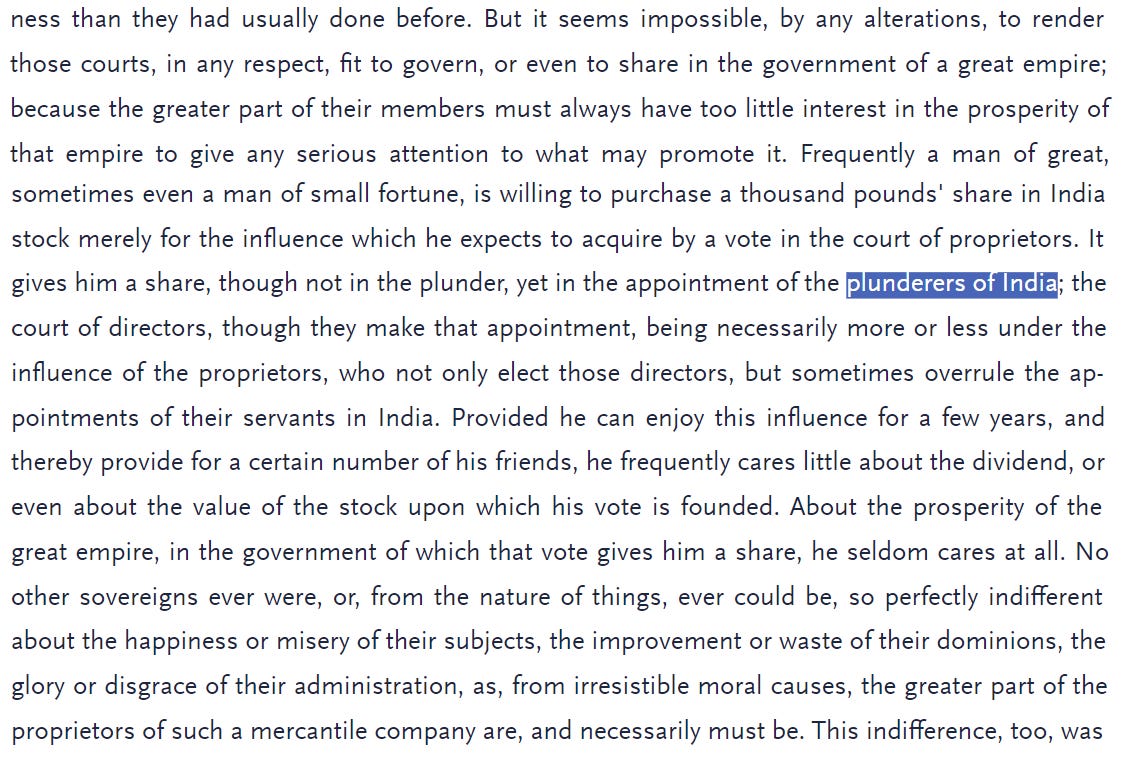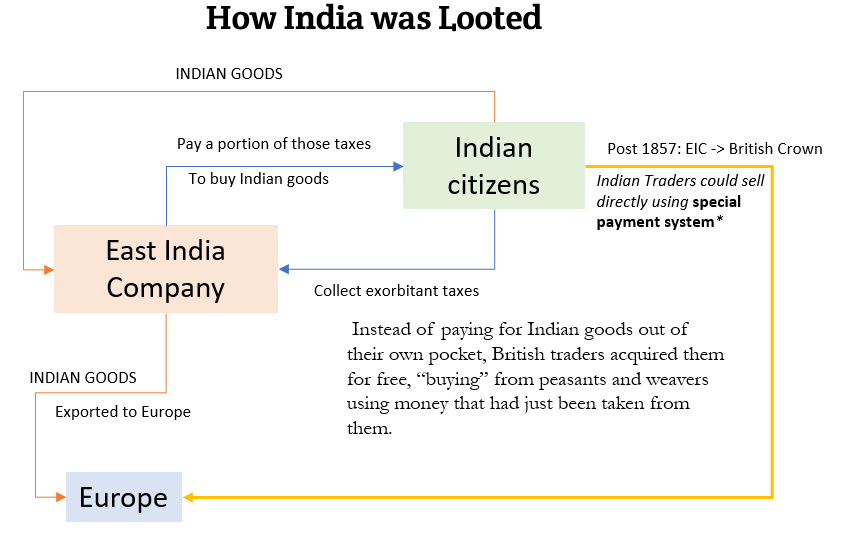Drishtikone Newsletter #360: Why is the West Rich?
Global North is rich and Global South poor. Peering into history we learn that plunder of India and Africa powered the industrial revolution and the riches of the North. Sobering and powerful investigation.
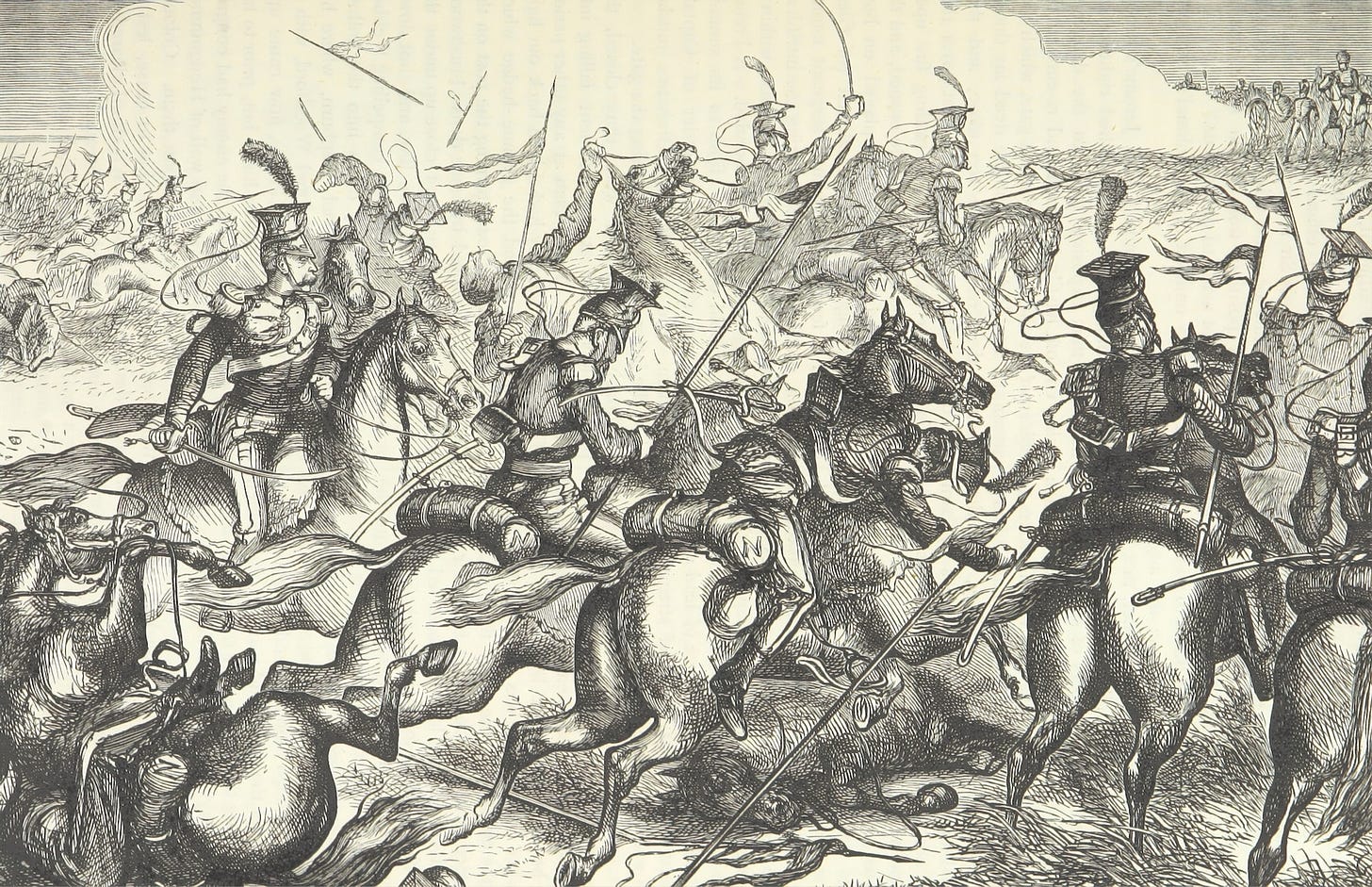

“The inquiring mind is rarely blessed with certainty; it must make shift with assumptions;” ― Rex Stout, Triple Jeopardy
World Trade Organization is a world body that says it deals with the rules of trade between nations. The fact is that profitable trade has never known any rules.
For trade to be a critical factor of growth, nations, and societies have since medieval times used force, slavery, colonial criminal enterprise, and mass massacres as the preferred tools.
When one looks back at the last 1000 years, one will find that the countries that became rich had no claim to real game-changing intellectual advantage to start with. They used criminal enterprises and genocides to create that advantage.
The story of the rise of the West is a very sobering one. It is not about a set of principles or a moral ethos that powered the modern "civilization" (if one can even call it). But about how unthinkably ruthless and remorseless criminality, which knew no end, overpowered everything else.
William Digby, a British writer, once wrote about the British colonial "trade" crimes:
With understanding may come a redeeming of the wrong; - may, more likely, may not.
He knew coloniality is a chronic mindset. That spans generations, political ethos, denominational divide, and faux spiritual spectrum. It is true only to the spoils of the enterprise.
Today's newsletter was one of the hardest to write given the information and was tough to come to terms with. But it is by far the most powerful one.
Staring at the Abyss
Liz Truss, the new UK Prime Minister has a tremendous crisis on her hands. A looming bankruptcy. An unprecedented rise in poverty. Falling GDP, and an energy crisis this winter.
In the week since the government unveiled the biggest tax cuts since 1972 with scant detail of how they will be financed, the pound has crashed to its lowest-ever level against the dollar, the cost of insuring British government debt against the risk of default has soared to the highest since 2016, and the Bank of England has been forced to intervene amid concerns about the nation’s pension funds. (Source: Bloomberg)
Some say that Britain is now on the verge of bankruptcy. Check out this excellent presentation from the Think School for even more details on the whole economic and social mess in the UK.
Now....
......Cut back to a little over a couple of hundred years ago.
The Plunder of India and the Western Wealth
Plunderers of India.
That is what Adam Smith, the celebrated economist called the office bearers of the East India Company.
Lord Salisbury, Secretary of State for India said in his Minute dated April 26th, 1875:
The injury is exaggerated in the case of India, where so much of the revenue is exported without a direct equivalent. As India must be bled the lancet should be directed to the parts where the blood is congested or at least sufficient, not to those” (the agricultural people) “which are already feeble from the want of it.”
Dadabhai Naoroji wrote in his book - Poverty and Un-British Rule in India - that the bar, which Salisbury talked about kept getting lower. Till it brought about famines and killed millions of Indians.
“.....those who were considered as having sufficient blood are also being brought lower and lower. The ‘want of blood’ among the agricultural population is getting so complete that famines and plagues like the present are fast bleeding the masses to death.” (Source: Poverty and Un-British Rule in India -download link)
The series of terrible droughts concentrated in Bengal, for it was the main area of British interests in the initial days and the hub of Indian agriculture and enterprise, were a testimony to the egregious policies of siphoning money off by the British.
The first dought in 1770 and then in 1783, 1866, 1873, 1892, 1897, and finally in 1943-44 were all engineered droughts. The first one started off in 1769 and went on until 1773 killing over 10 million people and wiping out a third of Bengal!
John Fiske discussed the magnitude and impact of the Bengal Famine of 1770. Per him, it was worse than the Black Plague of the 14th century!
The narrative portion of the present volume is concerned mainly with the social and economical disorganization wrought by the great famine of 1770, and with the attempts of the English government to remedy the same. The remainder of the book is occupied with inquiries into the ethnic character of the population of Bengal, and particularly with an exposition of the peculiarities of the language, religion, customs, and institutions of the Santals, or hill-tribes of Beerbhoom. A few remarks on the first of these topics may not be uninteresting. Throughout the entire course of recorded European history, from the remote times of which the Homeric poems preserve the dim tradition down to the present moment, there has occurred no calamity at once so sudden and of such appalling magnitude as the famine which in the spring and summer of 1770 nearly exterminated the ancient civilization of Bengal. It presents that aspect of preternatural vastness which characterizes the continent of Asia and all that concerns it. The Black Death of the fourteenth century was, perhaps, the most fearful visitation which has ever afflicted the Western world. But in the concentrated misery which it occasioned the Bengal famine surpassed it, even as the Himalayas dwarf by comparison the highest peaks of Switzerland. It is, moreover, the key to the history of Bengal during the next forty years; and as such, merits, from an economical point of view, closer attention than it has hitherto received. (Source: "The Unseen World and Other Essays" John Fiske / The Famine of 1770 in Bengal)
So you see, the high road and the noble language of the British officials notwithstanding, their devilry knew no limits.
The Drain
Dadabhai famously called this impoverishing of India using vile administrative policies the "Drain."
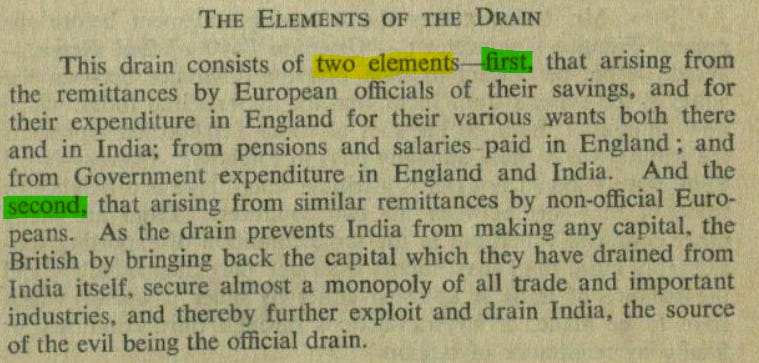
The Modus Operandi of the East India Company created a grand scale sucking of wealth.
Here’s how it worked. The East India Company began collecting taxes in India, and then cleverly used a portion of those revenues (about a third)to fund the purchase of Indian goods for British use. In other words, instead of paying for Indian goods out of their own pocket, British traders acquired them for free, “buying” from peasants and weavers using money that had just been taken from them. (Source)
Here is an illustration of how it actually happened.
That Indians were paying the taxes, a portion of which was used to buy the goods from Indian producers is bad enough, the British were exporting those goods to other countries in ways that would help them create huge gold reserves while the Indian traders, whose goods were used for this trade, got pittance in the Indian currency.
Basically, anyone who wanted to buy goods from India would do so using special Council Bills - a unique paper currency issued only by the British Crown. And the only way to get those bills was to buy them from London with gold or silver. So traders would pay London in gold to get the bills, and then use the bills to pay Indian producers. When Indians cashed the bills in at the local colonial office, they were “paid” in rupees out of tax revenues - money that had just been collected from them. So, once again, they were not in fact paid at all; they were defrauded. (Source)
This is illustrated below.
The Gold that was earned from Indian goods went to the British coffers, while the Indian producers remained poor!
How much was plundered? There have been different estimates by experts. Here is a sampling:
There have been several estimates of the drain of wealth from India to Britain. Furber (1948, p. 304) set out his formulation of the drain as follows: ‘the only true drain resulting from contact with the West was the excess of exports from India for which there was no equivalent import’. Furber estimated this drain to have been £11.8 million over the period 1783–1792 (at current prices), that is, an average of £1.3 million per annum. Other estimates of this drain include Maddison’s (1971) estimate of £100 million for the period 1757–1815; Hamilton’s (1919) and Sinha’s (1956) estimates of £34.5 million and £38.4 million, respectively, for the same period of 1757–1780; Burke’s (1981) estimate of £1 million per year for the 4 years ending 1780; and Habib’s (1974) estimate of well over £2 million for 1789–1790. A rigorous recent estimate is that by Cuenca Esteban (2001) for the period 1772–1820 whose figures show the ‘arguably minimum transfer’ from India to Britain—in the balance of payments sense—reaching a peak of £1.01 million annually in 1784–1792. (Source: India in the Rise of Britain and Europe: A Contribution to the Convergence and Great Divergence Debates by Prabir Bhattacharya/Adam Smith Business School)
The most authentic and quoted so far, however, has been by the Marxist economist, Utsa Patnaik.
As per Ms. Patnaik, Professor Emeritus at Jawaharlal Nehru University (JNU), the total drain between 1765 and 1938 was around $45 trillion.
Eminent Indian economist Professor Utsa Patnaik (Jawaharlal Nehru University) has estimated that Britain robbed India of $45 trillion between 1765 and 1938, However it is estimated that if India had remained free with 24% of world GDP as in 1700 then its cumulative GDP would have been $232 trillion greater (1700-2003) and $44 trillion greater (1700-1950). Deprivation kills and it is estimated that 1.8 billion Indians died avoidably from egregious deprivation under the British (1757-1947). (Source: Britain Robbed India Of $45 Trillion & Thence 1.8 Billion Indians Died From Deprivation / Concurrents)
Dadabhai was not the first one to talk about Drain from India to Britain.
Bhaskar Pandurang Tarkhadkar, Govind Vitthal Kunte (1816-47) aka Bhau Mahajan (1815-90), and Ramakrishna Vishwanath - all seniors of Dadabhai Naoroji at Elphinstone - had also used the "drain" to Britain from India as the central argument in their criticism of the colonial rule. Tarkhadkar and Kunte discussed the "draining India of its wealth and reducing it to poverty" while Ramakrishna Vishwanath wrote the book "Thoughts on India's Past, Its Present Condition, and Their Impact on the Future."
Drain theory had gained currency and it was apparent that the British were siphoning off India's wealth to push up the fortunes in Europe. And fund wars! Here is an excerpt from KM Munshi's book "The Ruin That Britain Wrought."
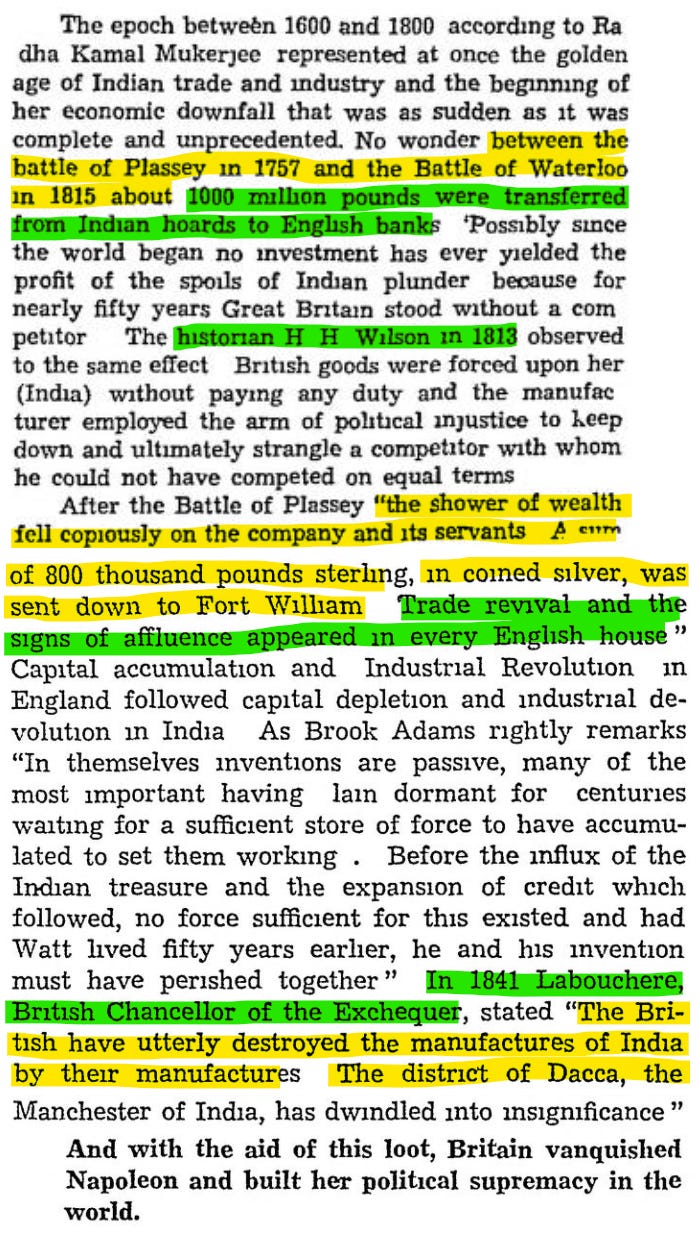
Not only were Britain and its cities built on the loot from India, but they were also able to finance their wars against Napolean and then the World Wars with money from India.
In fact, Nathan Rothschild is known to have used his deals with the East India Company (which per some sources he owned by that time) to finance the Waterloo battle against Napolean. Here is an excerpt from the Rothschild Archives.
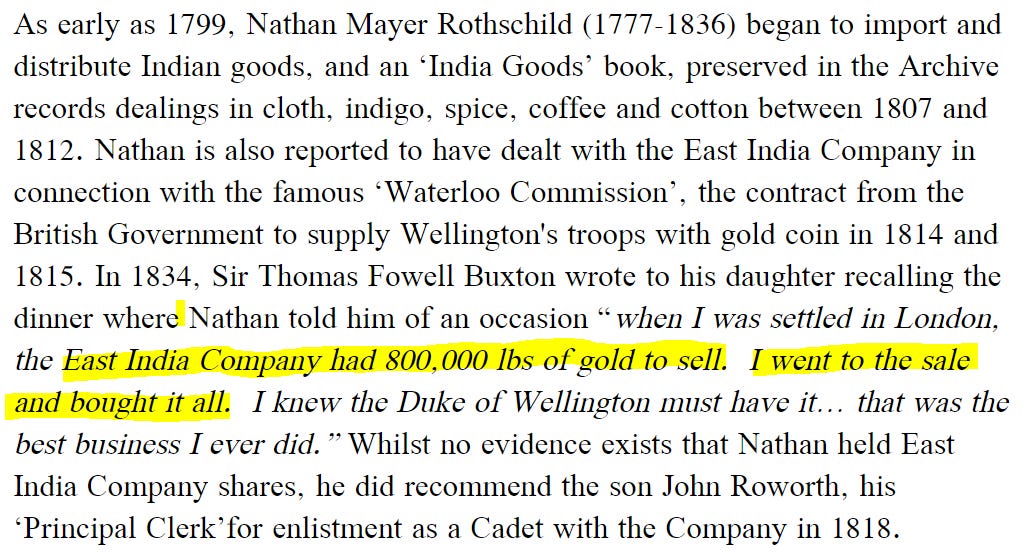
Many researchers have found substantial evidence of how plundered money from India financed the rise of England, its cities like London, and even the opulence in the countryside.
Dr. Arup Chatterjee author of the book "Indians in London" shares an interesting insight in his interview with the Indian Express.
The London that we are talking about was rebuilt after 1666 when most of its buildings were mutilated in the great fire. £37 billion were spent in reconstructing London. This money came from the taxes that the East India Company was paying to the Crown. It came not only from India but several other colonies. However, by the end of the 18th century India was giving Britain £43.2 million every year. And in 1813, the EIC’s assets in India were evaluated at £300 billion (in today’s value). London was practically rebuilt with Indian money. The city was and remains a non-physical extension of India. (Source: "How Indians made London, a new book has the story" / Indian Express)
Stephanie Barczewski, a professor at Clemson University, shared in her book “Country Houses and the British Empire, 1700-1930,” that "up to one in six manors were bought with the proceeds of imperialism, with at least two hundred and twenty-nine purchased by officials and merchants returning from India". These returning officials from India were called nabobs.
This included Chartwell, Winston Churchill’s family house, in Kent and "Bateman’s, the Jacobean home of Rudyard Kipling, in East Sussex." (Source: New Yorker)
For more information, please also read this newsletter.
Drishtikone Newsletter #339: British Opulence and Imperial Taproots
Recently, UK's National Trust was forced to acknowledge that 93 of its properties were built from colonial loot.
Large country houses in UK built with money looted or fortunes earned in colonial India are the focus of a new report by the National Trust, which owns and manages hundreds of historic houses, forts, castles and sylvan public spaces. At least 50 such properties in England and Wales are linked to the East India Company, whose employees earned fortunes in India and returned home to build large houses and live in splendour. Such returning wealthy individuals were called ‘nabobs’, who also wielded political power in Westminster in the 18th and 19th centuries. The trust has identified 93 properties linked to slavery and colonialism during the British Empire. The research is part of historical reviews initiated by several government departments and organisations in the wake of the Black Lives Matter campaign. (Source: "UK’s National Trust acknowledges colonial links to its properties" / Hindustan Times)
Britain's plunder of Indian wealth is, without doubt, the single most important factor that fueled its growth and prosperity.
What about other Europeans?
However, even the Portuguese and the Dutch established and set up trade routes in and around India. Portuguese rule was probably the most brutal.
Francisco de Almeida and Afonso de Albuquerque were cold-blooded killers, but they were also the chief architects of the permanent Portuguese presence in Asia. They were the first and second Viceroys of India and locked in fierce competition with one another. Crucially, both men, during their respective tenures, sought to expand the network of permanent fortified trading bases, stout forts along coastlines capable of withstanding prolonged sieges, in what was to be called the Estado da Índia—the state of India or Portugal’s Empire in the East. While under Almeida’s leadership, Portugal for the first time permanently stationed a fleet in Asia. And it was Albuquerque, who attempted to secure all strategic exit points of the Indian Ocean to put the entire oceangoing trade of the region under Portuguese control, a task for which Portuguese military resources, however, proved ultimately insufficient. (Source: The Diplomat)
Portuguese did not have enough numbers on their hands. That is why what they lacked in numbers, they made up in brutality.
“were few in numbers and those who would come to India in future fleets would always be at numerical disadvantage; so that this treachery must be punished in a manner so decisive that the Portuguese would be feared and respected in the future. It was their superior artillery which would enable them to accomplish this end.” (Source: The Diplomat)
Ultimately, it may have been this factor that led to their impact zone in India being confined to just the coastline in Goa and Kerala.
The Dutch came to India as well but were defeated by Anizham Tirunal Martanda Varma, the ruler of Travancore, in a battle at Kulachal in 1741. He forced them to go and set up a base in Indonesia.
Thus they went to Batavia or Djakarta.
The Vereenigde Oostindische Compagnie (VOC), better known as the Dutch East India Company was set up in 1602 and head-quartered in the Oost-Indisch Huis (East-India House) in downtown Amsterdam, which still stands today. It was founded as a private merchant company that was granted a two-decade-long monopoly by the government for spice trading mainly in the Dutch East-Indies, known today as the Republic of Indonesia. (Source: Dutch Review)
At its height during the Dutch Tulip mania, the VOC stocks were worth a whopping 78 million Dutch guilders (or $7.9 trillion USD worth now). That is the equivalent of Apple, Microsoft, Amazon, ExxonMobil, Berkshire Hathaway, Tencent, and Wells Fargo put together!
For this, they indulged in all kinds of colonial crimes like slave trading and imperial brutalities. They enslaved 50,000 Africans and used them in their colonies.
What was India's role in British Prosperity?
The question remains - was the Indian wealth and British plunder from India really instrumental in creating such a tremendous level of prosperity in the entire Western hemisphere?
The answer was given by the British journalist William Digby in his book 'Prosperous' British India; a revelation from official records which had extensive references from the book The Law of Civilization and Decay (1896) written by Brooks Adams, an American attorney, historian, and political scientist.
For context, Brooks Adams was the great-grandson of President John Adams (US Founding Father and the 2nd President of the US), a grandson of President John Quincy Adams (6th US President), and the youngest son of U.S. diplomat Charles Francis Adams (American historical editor, politician, and diplomat).
In this extract, Digby discusses how the plundered wealth from the Battle of Plassey was instrumental in starting the industrial revolution.
In many ways, the Battle of Plassey became the watershed with respect to the Industrial Revolution. You can divide the industrial evolution in terms of "before Plassey" and "after Plassey".
Digby shares powerful insights from Adams where the American historian considers money and resultant credit expansion key to manifesting innovations on a commercial scale.

The Battle of Plassey was fought in 1757. Brooks Adams said in “The Law of Civilization and Decay” that the pace of change that followed thereafter was unprecedented in Britain.
In 1760 John Kay's ‘Flying Shuttle’ (which revolutionized weaving) appeared and coal replaced wood in smelting
1764: James Hargraves invented the spinning-jenny
1768: James Watt patented the final design changes
1779: Samuel Crompton invented the spinning mule which revolutionized the text production
1785: Edmund Cartwright invented and patented the power loom
Adams suggested that the inventions did not accelerate the changes, but they were the outlets for growth that were powered by the money that flowed into Britain at that time.
In other words, just as without the Venture Capital available in Silicon Valley, no innovation could be possible in a commercial way, similarly without the Plassey money funding credit expansion and inflow of wealth, these innovations would not have found widespread use.
Printing, for example, was prevalent in China for centuries before it came to England, and Romans knew of gunpowder as well. Revolvers and cannons also existed since the 15th century while steam engines had been experimented on much before James Watt was born.
James Watt did not conceive of the Steam Engine for after all they were in use even before to pump water out of the mines. James Watt simply changed the design and made them more efficient and cheaper to run.
The guy who invested in James Watt's "invention" was Matthew Boulton. A man who made a fortune providing copper coinage for the East India Company. He also later supplied the machinery for the mints in Madras and Calcutta. (Source)
Before the money from Plassey flooded Britain, and the resultant expansion of credit happened, there was not enough force in the economy for these inventions and ideas to become the profitable force of the industrial revolution.
Plundered wealth from India was perhaps the greatest game-changer ever in human history.
"Possibly, since the world began, no investment has ever yielded the profit reaped from the Indian plunder"
Said Brooks Adams.
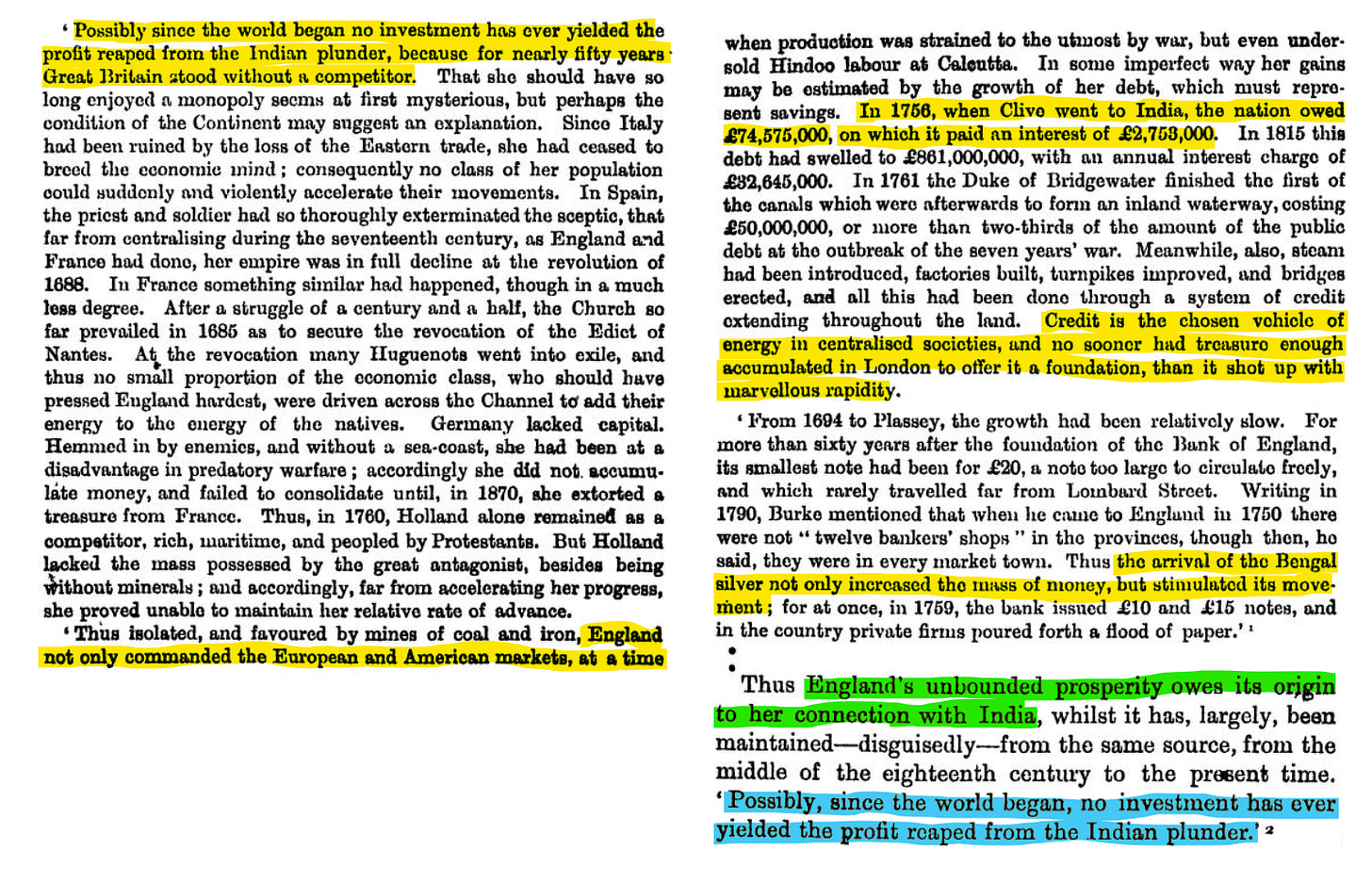
William Digby wrote in his book in complete anguish over what his country had done to India and what it had given in return.
With some of the money thus obtained England struck down the ancient industries of India, and, during a whole century, has done naught that is worthy to constitute India a land of varied industries. These be hard and cruel words for an Englishman to write. Written, however, they must be so as to help to an understanding of the wrong which has thus been done to India - and, in a deeper sense, to England. With understanding may come a redeeming of the wrong; - may, more likely, may not. (Source: 'Prosperous' British India; a revelation from official records by William Digby/ page 34)
This was how Britain's one exploit in India kick-started the British industrial revolution and subsequent thefts and plunders enabled it to become more prominent.
What about other colonial loot?
In 1745, Malachy Postlethwayt, the political economist, described the whole economic and trade situation in these famous words (Source: The Guardian):
"British trade is a magnificent superstructure of American commerce and naval power on an African foundation."
When we read the history of colonialism and slavery around the world, we miss the sophistry of European deceit and elaborate crimes camouflaged as trade.
Separate components and criminal enterprises that backed and powered each other.
What started off with the wealth from India, and slaves from Africa set in motion a colonial enterprise that was cruel, ruthless, immensely profitable plunder of nations and people sans any remorse!
In The Great Divergence, Kenneth Pomeranz asked why Europe, rather than China, made the breakthrough first into a modern industrial economy. To his two answers - abundant coal and New World colonies - he should have added access to west Africa. For the colonial Americas were more Africa's creation than Europe's: before 1800, far more Africans than Europeans crossed the Atlantic. New World slaves were vital too, strangely enough, for European trade in the east. For merchants needed precious metals to buy Asian luxuries, returning home with profits in the form of textiles; only through exchanging these cloths in Africa for slaves to be sold in the New World could Europe obtain new gold and silver to keep the system moving. East Indian companies led ultimately to Europe's domination of Asia and its 19th-century humiliation of China. (Source: The wealth of the west was built on Africa's exploitation by Richard Drayton/The Guardian)
Gold and silver from Africa -> Buy commodities in Asia -> Profits from commodities used to buy slaves -> Generate wealth in the Americas
One overall strategy with three important hubs.
People and resources from four continents - Africa, Asia, and the Americas (North and South) were enslaved, killed, and plundered.
Even when the colonial and imperial criminal enterprise was central to the wealth and prosperity of the West, these crimes were not just not acknowledged, they were erased.
What is more, French argues powerfully that there has been a deliberate attempt to erase Africa’s central role from the Western civilisational narrative and, at best to relegate it to the margins. In the process, people of African descent, whether on the continent itself or in the diaspora, are also relegated to the margins of global civilisational discourse and made to feel the full brunt of racist attitudes and brutality. (Source: How the West grew rich on gold and slavery)
While Indian wealth was instrumental in creating Britain which was indeed the most powerful and rich nation during the 19th century, the contribution of Africa in creating an unending source of raw material to keep the material affluence satiated cannot be questioned either.
Trillions of pounds of plunder of mineral and precious metals wealth were what kept the British ascendancy in place.
Beckford's experts estimated Britain's debt to Africans in the continent and diaspora to be in the trillions of pounds. While this was a useful benchmark, its basis was mistaken. Not because it was excessive, but because the real debt is incalculable. For without Africa and its Caribbean plantation extensions, the modern world as we know it would not exist. Profits from slave trading and from sugar, coffee, cotton and tobacco are only a small part of the story. What mattered was how the pull and push from these industries transformed western Europe's economies. English banking, insurance, shipbuilding, wool and cotton manufacture, copper and iron smelting, and the cities of Bristol, Liverpool and Glasgow, multiplied in response to the direct and indirect stimulus of the slave plantations. (Source: The wealth of the west was built on Africa's exploitation, The Guardian)
Do you see how the Western powers sucked the wealth, money, minerals, and enslaved people to create a paradise for themselves?
Apparently, in perpetuity.
Cruel Condescending Colonial Structures continue
As Vijay Prashad, the Marxist historian said in a speech that went viral, the rich Western nations created colonial structures that emanated from their colonial mindset. These colonial structures, like the IMF, took the money that was stolen from the "Global South" and turned around to patronizingly offer it back as debt!
Condescension at its cruelest?
And, if you think that the colonial plunder ended with colonial rule, think again!
Jason Hickel, Dylan Sullivan &Huzaifa Zoomkawala wrote an interesting paper in 2021 titled "Plunder in the Post-Colonial Era: Quantifying Drain from the Global South Through Unequal Exchange, 1960–2018" that the global North or the advanced economies had drained $62 trillion (constant 2011 dollars), or $152 trillion when accounting for lost growth from the global South between 1960 to now!
For every dollar the global South receives in aid from the agencies managed by the global North, they lose $14 in drain through the mechanism that fundamentally perpetrates an unequal exchange!
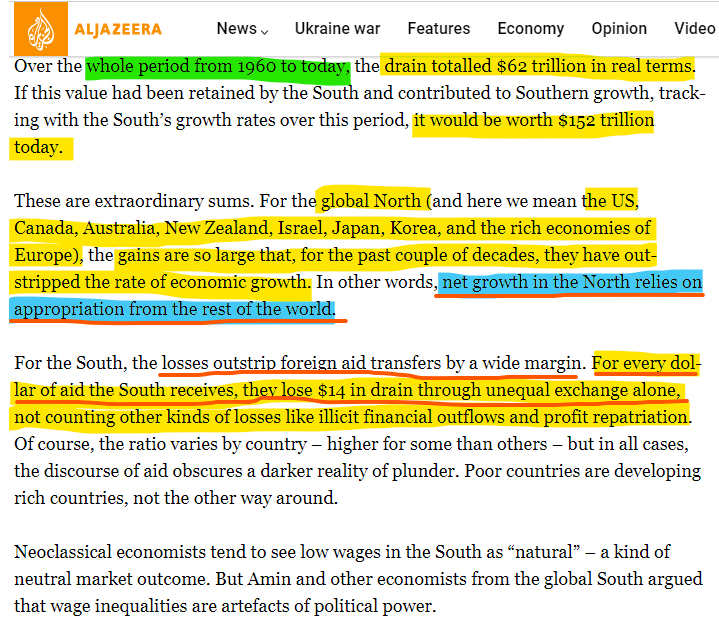
This money merry-go-round where the global South, specifically sub-Saharan Africa, loses out to the rich countries and indeed the world has also been underscored by other research studies. One, funded by Global Justice Now, (link) says that while $161bn a year comes into Africa in the form of loans and remittances; $203bn leaves the continent in the form of corruption and other reasons.
That’s the essence of a report (pdf) from several campaign groups released today. Based on a set of new figures, it finds that sub-Saharan Africa is a net creditor to the rest of the world to the tune of more than $41bn. Sure, there’s money going in: around $161bn a year in the form of loans, remittances (those working outside Africa and sending money back home), and aid. But there’s also $203bn leaving the continent. Some of this is direct, such as $68bn in mainly dodged taxes. Essentially multinational corporations “steal” much of this – legally – by pretending they are really generating their wealth in tax havens. These so-called “illicit financial flows” amount to around 6.1 percent of the continent’s entire gross domestic product (GDP) – or three times what Africa receives in aid. (Source: Africa is not poor, we are stealing its wealth, Nick Dearden)
Theft and plunder still. That is all the rich know.
That is all that floats them really!
Wait, but the Nordics did not colonize, did they?
Many European colonialism apologists say that the European riches and development were not predicated on the loot and plunder from Africa and Asia. If that were so, then how do you account for the rich Nordic countries?
They did not colonize anyone.
Well, since this topic has been broached by many in such clear terms, then the answer needs to be as direct as well.
Nordic countries were not the colonizers. But the parasites. They did not get the biggest spoils or rule the countries or regions, but simply exploited what they could.
Trading companies, owned or backed by governments, built trading posts and administered land at the fringes of European exploration. British, French or Dutch empires were not the only speculators. Denmark established 30 forts, lodges and stations along the West African Coast. Between 1626 and 1825, Danish vessels shipped almost 100,000 enslaved Africans through these Scandinavian forts. The Danish East India Company held posts as far from Jutland as Tamil Nadu and Bengal, and settled three sugar islands in the Caribbean – the ‘Danish West Indies’ – while Sweden took the Caribbean island of St Barthélemy. Under 18th-century mercantilist empires, these trading companies and their forts, monopolies and gunpowder were the only legitimate way for a country to funnel profits from the New World (and Africa and Asia) into their treasuries. Navigation Acts aimed to ensure that raw materials and investments of empire moved only between ‘mother country’ and ‘colony’. Smaller countries were shut out of the most lucrative lands in, say, St Domingue or Barbados. This left them to establish their own ventures in the leftover or marginal spaces. Scotland, for instance, shut out of trade with English colonies, tried to make good the swampy, gnat-infested, Darién gap in modern-day Panama at the end of the 17th century. After the Darién colony failed, Scotland turned in 1707 to formal Union with England. Monarchs in Copenhagen and Stockholm tried to establish their own colonies to face a powerful world of mercantilist competitors. (Source: "The Scandinavians ‘hitchhiked’ their way to the boons of empire" / Aeon)
Hitchhiking is a fancy word for playing a parasite. Here is an oil painting showing the Swede colonizers in St. Barthélemy.
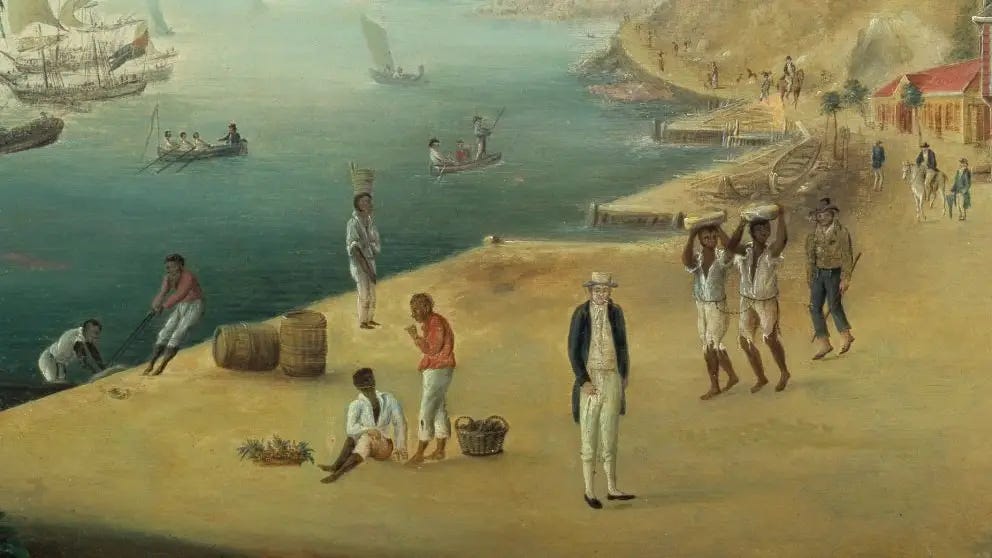
There are researchers who have found records that have been hitherto hidden that recount the colonial crimes of the Nordic forces. The benign image of the Nordic countries notwithstanding, the Nordic rulers replicated the ways of regular colonialists like the French and the British and treated the slaves in an equally cruel way.

Bottomline - their crimes were no less.
The real picture of the Global Rich and Poor
Are you not wondering then who is rich and who is poor?
Did the West become rich because it was advanced or did it become rich because it was vile, cruel, ruthless, cunning, shamelessly inhuman?
Hundreds of millions, if not billions killed ruthlessly via famines and droughts manufactured by powerful armies and imperial rulers. Billions were enslaved and treated as no one with an ounce of humanity would treat any other being, leave alone a human.
All that for what?
Prosperity or as William Digby framed it 'Prosperity', suspect as it was, built upon the flesh, blood, and bodies of uncountable kids, women, and men who had no animosity for their vanquishers.
No, Western prosperity and industrial 'advancement' had nothing to do with creativity or innovation but about cruel violent endeavors that were shorn of all moral principles.
If even after all this plunder, death, slavery, and cruelty Britain was an invincible growth story where the masses were living in prosperity and happiness, one could still argue that it all this evil-doing was worth it for at least them. However diabolical that argument maybe
The fact is that less than a century after plundering $45 trillion dollars from India and trillions more still from Africa and other nations, Britain is sinking into debt and barely saving itself from bankruptcy!
The only thing that can help them is the furthering of their theft and loot in Africa and other nations.
That is all they have known.
When William Digby said this, he knew that the imperial mindset is a chronic criminal ailment that besets those who have tasted its dirty and filthy, yet profitable, consequences.
Written, however, they must be so as to help to an understanding of the wrong which has thus been done to India - and, in a deeper sense, to England. With understanding may come a redeeming of the wrong; - may, more likely, may not.
That Britain and others do not know of any other way to thrive, or even survive, than to plunder from others, the chances that they can keep their economies afloat in a just world is extremely low.
Falling out of Brexit, having little advantage over others in different fields, and not much money to play with, their own historical karma is now their greatest enemy!
It is no wonder that Britain fell behind India in its overall GDP this year (Source) - exactly 75 years after it had exited its shores.
That India was able to do that showed that it had the mechanism of fighting the odds and beating a bully even in a fair fight of economic vagaries. That Britain fell behind despite its loot showed that it had no other ploy at its disposal.
Loss of Imperial ascendancy resulted in a sinking world for these imperial powers.
Very interestingly, many have raised an ask for justice that needs to be done for the colonial past - reparations.
That money Britain drained from India should be returned back.
The fact however is that it's not that Britain may not want to return the money. But that it cannot!
How more pitiable can it get?
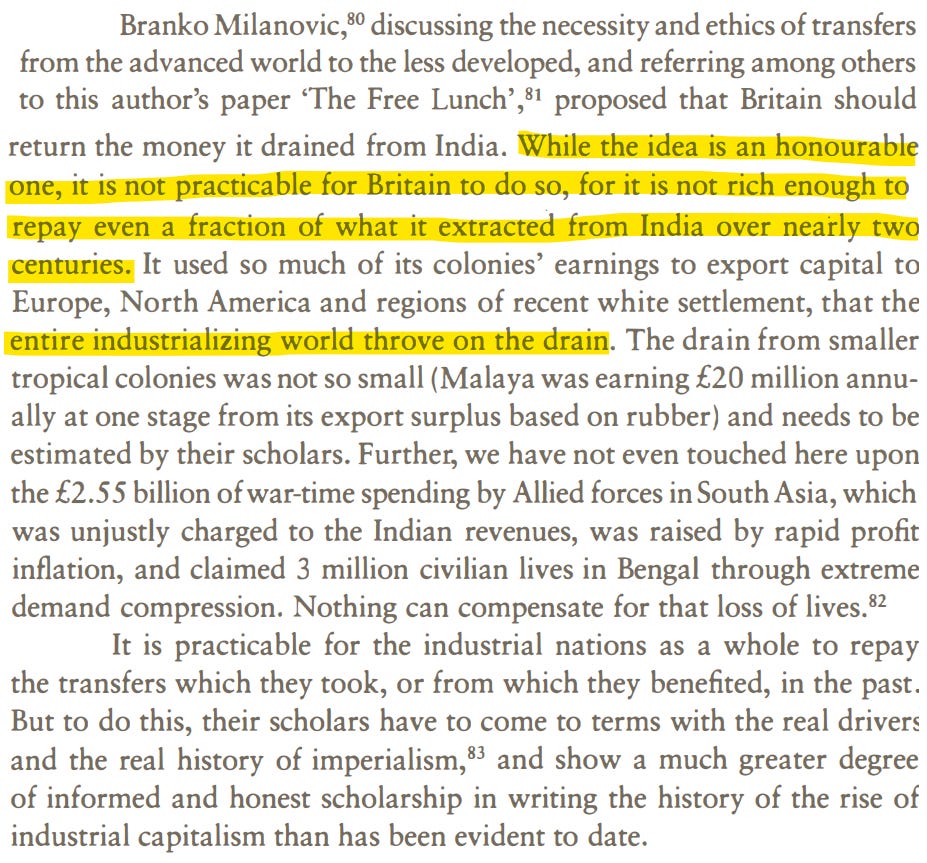
Video Corner: Is Reality a Controlled Hallucination?
Consciousness has an important connotation in spirituality. Very different from how neo-scientists, specifically those who have been engaged in robotic and AI research.
They have been working to provide will and awareness and an ability to make decisions for the machines. Here is a very interesting sharing from Anil Seth, Professor of Cognitive and Computational Neuroscience at the University of Sussex, where he is also the Co-Director of the Sackler Centre for Consciousness Science.
If you like our content and value the work that we are doing, please do consider contributing to our expenses. CHOOSE THE USD EQUIVALENT AMOUNT you are comfortable with.
If you like this post - please share it with someone who will appreciate the information shared in this edition.
Today’s ONLINE PAPER: Check out today’s “The Drishtikone Daily” edition. - THE DRISHTIKONE DAILY




